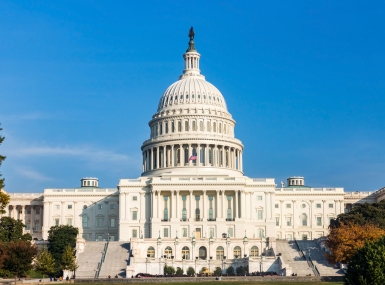Legislative Analysis: Impact of PFAS Regulations on Counties

Upcoming Events
Related News
What are PFAS?
PFAS are a group of synthetic chemicals that have been manufactured and used in a variety of industries since the 1940s. Due to their non-stick properties and ability to resist heat, oil, stains, grease and water, PFAS can be found in nonstick cookware, waterproof clothing, food packaging, stain resistant fabrics and a certain type of firefighting foam known as aqueous film forming foam (AFFM).
PFAS has been found in the air, land and water of communities across the country. Commonly referred to as “forever chemicals,” PFAS can persist in the environment for decades and can negatively affect human health. Exposure can occur in a variety of ways, including by breathing air containing PFAS, drinking water contaminated with PFAS and swallowing soil or dust contaminated with PFAS.
Jump to Section
What are PFAS?
PFAS are a group of synthetic chemicals that have been manufactured and used in a variety of industries since the 1940s. Due to their non-stick properties and ability to resist heat, oil, stains, grease and water, PFAS can be found in nonstick cookware, waterproof clothing, food packaging, stain resistant fabrics and a certain type of firefighting foam known as aqueous film forming foam (AFFM).
PFAS has been found in the air, land and water of communities across the country. Commonly referred to as “forever chemicals,” PFAS can persist in the environment for decades and can negatively affect human health. Exposure can occur in a variety of ways, including by breathing air containing PFAS, drinking water contaminated with PFAS and swallowing soil or dust contaminated with PFAS.
PFAS Regulatory Actions
On April 19, EPA designated two PFAS chemicals as hazardous substances under CERCLA, better known as the Superfund law. The designation represents one of the latest actions taken by the Agency as part of its PFAS Strategic Roadmap to clean up and prevent PFAS contamination.
The rule could place a significant economic burden on counties, as PFAS is suspended in the environment which leads to accumulation in water systems, landfills and other facilities owned or operated by counties. Given the ubiquity of PFAS, county governments, water systems, landfills, and airports could be subject to the rule’s reporting and financial liability requirements.
What Should Counties Know About the Designation of PFAS as Hazardous Substances Under CERCLA?
On April 19, EPA designated two PFAS chemicals as hazardous substances under CERCLA, better known as the Superfund law. The designation represents one of the latest actions taken by the Agency as part of its PFAS Strategic Roadmap to clean up and prevent PFAS contamination.
The rule could place a significant economic burden on counties, as PFAS is suspended in the environment which leads to accumulation in water systems, landfills and other facilities owned or operated by counties. Given the ubiquity of PFAS, county governments, water systems, landfills, and airports could be subject to the rule’s reporting and financial liability requirements.
The final rule designates perfluorooctanoic acid (PFOA) and perfluorooctanesulfonic acid (PFOS), including their salts and structural isomers, as hazardous substances under CERCLA. PFOA and PFOS are the two most well-understood PFAS chemicals.
The designation of PFOA and PFOS as hazardous substances under CERCLA:
- Authorizes EPA to investigate releases of PFOA and PFOS and compel potentially responsible parties (PRPs), including owners and operators of facilities and vessels, to clean up contaminated sites or to reimburse EPA for the cost of cleanup;
- PRPs are also able to sue other parties they believe to be responsible for contamination, such as county governments, to recover cleanup costs
- Requires entities that release one pound or more of PFOA and PFOS within a 24-hour period to report the release to the National Response Center, state or tribal emergency response commission, and the local or tribal emergency planning committee;
- Requires federal entities that sell property to provide information on the storage, release or disposal of PFOA or PFOS on the property and guarantee that it has cleaned up any contamination or will do so in the future if necessary; and
- Requires the U.S. Department of Transportation to list and regulate PFOA and PFOS as hazardous under the Hazardous Materials Transportation Act.
EPA released a PFAS Enforcement Discretion and Settlement Policy alongside the final rule. The policy outlines that EPA will focus its enforcement actions on entities that significantly contributed to the release of PFOA and PFOS into the environment, including manufacturers of PFAS, parties that have used PFAS in the manufacturing process, federal facilities and other industrial parties.
It further outlines that EPA does not intend to hold entities responsible where equitable factors do not support seeking response actions or costs, including:
- Community water systems and publicly owned treatment works
- Municipal separate storm sewer systems
- Publicly owned/operated municipal solid waste landfills
- Publicly owned airports and local fire departments
- Farms where biosolids are applied to the land
The factors that EPA will consider in exercising its enforcement discretion policy include:
- Whether the entity is a state, local, or tribal government, or works on behalf of or conducts a service that otherwise would be performed by these entities
- Whether the entity performs a public service role
- Whether the entity manufactured PFAS or used PFAS as part of an industrial process
- Whether, and to what extent, the entity is actively involved in the use, storage, treatment, transport, or disposal of PFAS
The enforcement discretion policy suggests that EPA does not intend to hold county governments liable with regard to the release of PFOA and PFOS under CERCLA. However, the enforcement discretion policy does not prevent other PRPs from suing county governments to recover cleanup costs (though it is worth noting that EPA will seek to require PRPs to waive their right to sue entities covered under the policy as part of their settlements). Additionally, the policy is not legally binding and nothing included in the policy prevents a future administration from revoking it.
What Happens Next?
The rule will take effect 60 days after publication in the Federal Register. EPA is also considering whether to designate additional PFAS, including GenX chemicals, as hazardous substances under CERCLA.
NACo will continue to advocate for legislation that ensures that local governments are explicitly recognized as passive receivers of PFAS and are provided narrow exemption from liability under CERCLA with regard to these chemicals. If not granted an exemption, counties could be forced to pay for the clean up of substances they had no role in the creation or distribution of – shifting the “polluter pays” principle of the law to that of a “community pays” model placing the burden of compliance and cleanup onto ratepayers and our residents.
What Should Counties Know About the PFAS Drinking Water Regulation?
On April 10, EPA released its National Primary Drinking Water Regulation (NPDWR) for six PFAS chemicals under the Safe Drinking Water Act (SDWA). The NPDWR represents is one of the actions outlined in the Agency’s PFAS Strategic Roadmap. The rule is expected to place a significant economic burden on public water systems.
Community water systems and non-transient non-community water systems must comply with the regulation. In total, 66,000 public drinking water systems will be subject to the rule and EPA expects 6 to 10 percent of them will need to take action to reduce PFAS to meet the new standards.
The rule sets enforceable Maximum Contaminant Levels (MCLs) and non-enforceable Maximum Contaminant Level Goals (MCLGs) for six types of PFAS.
Compound | Final MCLG (non-enforceable) | Final MCL (enforceable) |
PFOA | Zero | 4.00 parts per trillion (ppt) |
PFOS | Zero | 4.00 ppt |
PFHxS | 10 ppt | 10 ppt |
PFNA | 10 ppt | 10 ppt |
HFPO-DA (GenX Chemicals) | 10 ppt | 10 ppt |
Mixtures containing two or more of PHFxS, PFNA, HFPO-DA, and PFBS | 1 (unitless) Hazard Index* | 1 (unitless) Hazard Index* |
*A Hazard Index is a measure used to determine the health concerns associated with exposure to chemical mixtures. EPA is in the process of creating an online calculator to help water systems determine their Hazard Index results.
Within three years (by 2027):
- Public water systems must complete initial monitoring for the above PFAS
Beginning in three years (starting 2027):
- Public water systems must complete initial monitoring and the results must be included in Consumer Confidence Reports
- Public water systems must begin regular compliance monitoring, and the results of compliance monitoring must be included in Consumer Confidence Reports
- Public water systems must provide public notification for monitoring and testing violations
Beginning in five years (starting 2029):
- Public water systems must comply with all MCLs for the above PFAS
- Public water systems must provide public notification if the MCLs for the above PFAS are exceeded
EPA estimates the compliance cost of the regulation to be approximately $1.5 billion per year., including costs associated with monitoring, communicating with the public, and installing and maintaining treatment technologies as necessary. However, compliance cost estimates from the American Water Works Association range from $2.5 to $3.2 billion annually.
The compliance cost of the regulation is significant and will ultimately be passed onto consumers through rate increases and long-term debt, particularly where advanced treatment is required.
EPA does not require public water systems to use any particular method to remove PFAS from drinking waters if levels exceed the MCLs. However, in a fact sheet published alongside the PFAS NPDWR EPA outlines the following as the “Best Available Technologies” to meet the MCLs:
- Granular Activated Carbon: Contaminated water is passed through a pressure vessel or filter box containing granular activated carbon and the PFAS “sticks” to the activated carbon.
- Anion Exchange: Contaminated water is passed through a vessel containing anion exchange media, and the anions from the media (normally chloride or hydroxide) are exchanged for PFAS.
- Reverse Osmosis and Nanofiltration: Reverse osmosis and nanofiltration are high pressure membrane processes that split water into two streams – clean water and contaminated water
Notably, these technologies only remove PFAS from drinking water. After it is removed, the PFAS must be disposed of, destroyed, or stored, creating additional costs and challenges for local governments. Alongside the regulation, EPA released updated guidance on the destruction and disposal of PFAS. The guidance provides information on available methods to remediate, dispose of and destroy PFAS including thermal destruction, landfills and underground injection.
What Happens Next
The rule will take effect on June 25, 2024. NACo will continue to advocate for increased funding for local governments to address water infrastructure needs in their communities and for federal action to prevent future PFAS contamination, including source reduction.
PFAS Legislation
The Senate Environment and Public Works Committee’s Draft PFAS Legislation
In June 2023, the Senate Environment and Public Works (EPW) Committee released draft legislation on PFAS. The draft legislation includes provisions that NACo is supportive of, including measures that would prevent PFAS pollution and to clean up PFAS in the environment. However, the draft legislation does not include language to provide local governments with a narrow exemption from liability under CERCLA with regard to PFAS. NACo has continued to urge the EPW Committee to include such an exemption in any final legislation to ensure that local governments are not held financially responsible for cleaning up chemicals they had no role in manufacturing or distributing, including through leaders which you can read here.
PFAS Funding
Funding for PFAS in Water
While insufficient to address the nation’s water infrastructure needs, the Bipartisan Infrastructure Law provides $10 billion over five years (FY 2021 – FY 2026) to address PFAS and other emerging contaminants in drinking water and wastewater. This funding is available as grants through the Clean Water and Drinking Water State Revolving Funds and the Small, Underserved, and Disadvantaged Communities Grants program. Given that both programs flow through the states, counties should work with their state department of environment or other applicable entity to access the fund.
EPA also offers Water Technical Assistance (WaterTA) services to help communities identify water challenges, develop plans, build capacity, and develop application materials to apply for water infrastructure funding.
Funding for PFAS at Airports
The Transportation Appropriations Bill for Fiscal Year 2024 provided $5 million to the U.S. Department of Transportation (DOT) for demonstration projects at airports to collect and remove aqueous film forming foam (AFFM) and other PFAS waste, as well as to field test and measure PFAS destruction technologies.





